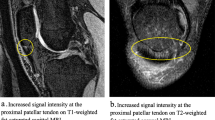Abstract
Thickening of the patellar tendon and foci of increased signal intensity have been described as characteristic features of “jumper's knee” (chronic patellar tendinitis) on magnetic resonance imaging (MRI). It was our impression that such appearances may be seen in the patellar tendons of patients without symptoms referable to the anterior part of the knee when using gradient echo images. The appearances of the asymptomatic patellar tendon on three-dimensional gradient echo sequences were studied by retrospectively reviewing the images of 60 patients, none of whom had symptoms related to the anterior part of the knee. The anteroposterior width of the patellar tendon was measured at three levels (superior, middle and inferior) on the central sagittal image of a gradient echo sequence. The relative signal intensities at the same levels were recorded. In 97% of subjects the superior part of the tendon was wider than the midpoint, and in 97% the inferior part was wider than the midpoint. The range of widths was wide, and there was no significant difference between sexes. Focal increased signal intensity in the superior part was shown in 75%, and in the inferior part in 43%. The asymptomatic patellar tendon shows uniform thickness throughout most of its length, but there are focal expansions at the proximal and distal ends. It usually demonstrates low signal on MRI, but may contain foci of increased signal intensity at either or both ends when imaged on gradient-echo sequences.
Similar content being viewed by others
References
Williams PL, Warwick R, eds. The knee joint. In: Gray's anatomy, 36th edn. Edinburgh: Churchill Livingstone, 1980: 485.
Bodne D, Quinn SF, Murray WT, Bolton T, Rudd S, Lewis K, Daines P, Bishop J, Cochran C. Magnetic resonance images of chronic patellar tendinitis. Skeletal Radiol 1988; 17: 24.
Davies SG, Baudouin CJ, King JB, Perry JD. Ultrasound, computed tomography and magnetic resonance imaging in patellar tendinitis. Clin Radiol 1991; 43: 52.
El-Khoury GY, Wira RL, Berbaum KS, Pope TL Jr, Monu JUV. MR imaging of patellar tendinitis. Radiology 1992; 184: 849.
Kälebo P, Swärd L, Karlsson J, Peterson L. Ultrasonography in the detection of partial patellar ligament ruptures (jumper's knee). Skeletal Radiol 1991; 20: 285.
Deutsch AL, Mink JH, Kerr D, eds. MRI of the foot and ankle. New York: Raven, 1992: 137.
Markisz JA, ed. MRI, CT, nuclear medicine and ultrasound in clinical practice. New York: Little Brown, 1991: 329.
Mink JH, Deutsch AL, eds. MRI of the musculoskeletal system. New York: Raven, 1990: 443.
Heron CW, Calvert PT. Three-dimensional gradient-echo MR imaging of the knee: comparison with arthroscopy in 100 patients. Radiology 1992; 183: 839.
Spiers ASD, Meagher T, Ostlere SJ, Wilson DJ, Dodd CAR Can MRI of the knee affect arthroscopic practice? A prospective study of 58 patients. J Bone Joint Surg [Br] 1993; 75: 49.
Gueckal C, Jundt G, Kirsch E, Gaechter A, Rudin A. SE and 3D GRE MR imaging of the knee joint: in vivo and in vitro results. Radiology 1993; 189(P): 208.
Chien D, Edelman RR. Ultrafast imaging using gradient echoes. Magn Reson Q 1991; 7: 31.
Elster AD. Gradient-echo MR imaging: techniques and acronyms. Radiology 1993; 186: 1.
Beltran J, Noto AM, Herman LJ, Lubbers LM. Tendons: highfield-strength, surface coil MR imaging. Radiology 1987; 162: 735.
Fullerton GD, Cameron IL, Ord VA. Orientation of tendons in the magnetic field and its effect on T2 relaxation times. Radiology 1985; 155: 433.
Tehranzadeh J, Kerr R, Amster J. Magnetic resonance imaging of tendon and ligament abnormalities: part 2. Pelvis and lower extremities. Skeletal Radiol 1992; 21: 79.
Berlin RC, Levinsohn EM, Chrisman H. The wrinkled patellar tendon: an indication of abnormality in the extensor mechanism of the knee. Skeletal Radiol 1991; 20: 181.
Erickson SJ, Prost RW, Timins ME. The “magic angle” effect: background physics and clinical relevance. Radiology 1993; 188: 23.
Erickson SJ, Cox IH, Hyde JS, Carrera GF, Strandt JA, Estkowski LD. Effect of tendon orientation on MR imaging signal intensity: a manifestation of the “magic angle” phenomenon. Radiology 1991; 181: 389.
Author information
Authors and Affiliations
Rights and permissions
About this article
Cite this article
Reiff, D.B., Heenan, S.D. & Heron, C.W. MRI appearances of the asymptomatic patellar tendon on gradient echo imaging. Skeletal Radiol. 24, 123–126 (1995). https://doi.org/10.1007/BF00198074
Issue Date:
DOI: https://doi.org/10.1007/BF00198074




